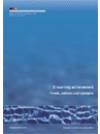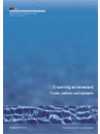This report presents a view of tertiary e-learning achievement from 2004 to 2009. This report compares completion rates in courses that are delivered with e-learning to those that are delivered by traditional methods. The report will also establish which of the e-learning delivery modes had higher and lower course completion rates. Finally, trends in course completion rates over time are discussed.
Key Results
- Face-to-face courses had higher completion rates than e-learning courses overall. But in some groups – full-time students, intramural students, university students and Asian students – there was little difference in the completion rates of e-learning and courses delivered by traditional methods.
- This finding for Asian students challenges much of the evidence from the wider research literature which finds that Asians do badly in e-learning because they are thought to favour more directive teaching styles.
- The other groups, polytechnic students, extramural students, part-time students, Māori and Pasifika, older students, and women had an advantage in face-to-face, paper-based delivery courses.
- Much of the research literature indicates that women do better than men in e-learning because e-learning requires greater self-management. But we find evidence for e-learning being relatively less advantageous for women.


